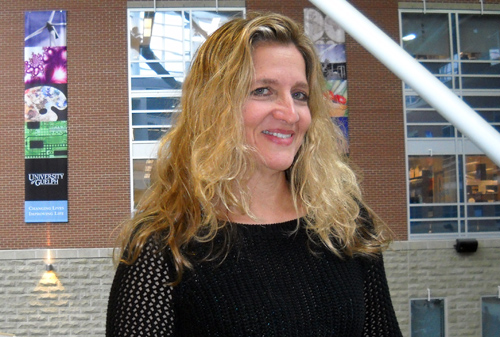
You’ve struggled through weight training and spin classes. You’ve swallowed all of the fad diets. Maybe you’ve even subjected yourself to fitness “boot camp.” So why is nothing working to keep you in the shape you want?
Rather than turn your life upside down to accommodate the gym or the diets, why not make your physical activity and fitness regimen suit your lifestyle?
That’s the message Felicia Cavallini hopes to share with her U of G colleagues this semester as a Fulbright Canada scholar in the Department of Human Health and Nutritional Sciences (HHNS). She arrived in Guelph this month from South Carolina, where she’s a professor in the physical education department at Limestone College in Gaffney.
If Cavallini was looking for signs of interest in her field on this side of the border, she didn’t have to look far. When people find out about her expertise in health, wellness and fitness, they’re often eager to chat – even the Canada Customs officer on Labour Day weekend who sighed over trying to fit exercise around her work and home life.
Then there was the restaurant waiter in Niagara-on-the-Lake who talked to Cavallini about bike lanes and walking trails. “It’s important to know about accessibility to different means of exercise,” she says.
How important? In the United States, one in three children is obese or overweight – a figure that is mirrored by adults in that country. In some American counties, more than half of all adults are in that group, making them more vulnerable to everything from heart disease to Type 2 diabetes.
What’s driving weight gain? The factors include a plugged-in world encouraging a sedentary lifestyle, a fast-food culture and reluctance among parents – particularly single moms – to allow kids to stray far from home.
“Kids today are tied to their computers,” says Cavallini.
Now 51, she grew up in San Antonio, Texas, where she was an all-state athlete in high school basketball, volleyball and track. “When I was young, we were gone all day long playing all kinds of sports and riding horses. I was always a tomboy. Research indicates the patterns we establish in our youth carry over into adulthood.”
What little she has seen of her home away from home suggests that Canadians are better off. “I see an active community here at Guelph,” she says, referring to the riverside cycling and walking trail near her rented downtown accommodations.
Still, she says Canada faces the same factors and trends as Americans. How to keep people fit and prevent further drains on an already costly public health-care system?
Look to those trails for a clue, says Cavallini. For most people, fitness is more about lifestyle and modifying behaviour than about creating a nation of gym rats.
That kind of message resonates with Guelph researchers in exercise science and nutrition, says Prof. Lawrence Spriet, HHNS chair. “We like to call ourselves the lifestyle department,” he says. “It’s not so much putting people into traditional exercise: it’s more that you have to build it into your daily life. Lots of people would never want to set foot in a gym or play on a sports team but could be convinced to walk to work, to ride to work, take the stairs. Add that up and it can be quite productive.”
Along with colleagues in the Department of Family Relations and Applied Nutrition, several HHNS researchers launched the Guelph Family Health Study this year. That study will ultimately track thousands of area families over decades to see which exercise and nutrition changes keep people more healthy.
Cavallini plans to look into ways to share the lifestyle message with the public through print media, the internet or social media. She’s talking with external groups such as the local public health agency. She hopes to work with HHNS students on outreach to encourage people to pursue physical activity from walking and skating to resistance training.
She will also look at barriers to exercising, such as time management and environmental factors, and what motivates people to get moving. Is a defined goal the best motivator? Are people exercising partly for the social benefits? Is it a cause such as Relay for Life that gets people involved?
Cavallini knew little about Guelph before arriving last month, but she’s learning fast. Referring to HHNS, she says: “This is a very strong research unit. The University of Guelph is known for innovation and creativity.”
She played varsity basketball and volleyball while studying kinesiology and education at Rice University in Houston. She earned an MA in education at the University of Texas at San Antonio and coached women’s basketball there and at other colleges before completing a doctorate in education at the University of Houston.
Cavallini joined Limestone College in 1995. She has published and presented nationally and internationally on topics ranging from physical activity levels within populations to a walking trail project in the City of Gaffney. “I want to help people have a better quality of life.”